You cannot like this item. Reason: "ANONYMOUS".
You cannot remove your like from this item.
Editing a post is only allowed within 24 hours after creating it.
You cannot Like this post because the topic is closed.
Copy the URL below to share a direct link to this post.
This post cannot be edited using the classic forums editor.
To edit this post, please enable the "New forums experience" in your settings.
Hello Dan, I have the same equipment as you and recently photographed M81 and M82 without any problems in an urban environment. See my astrobin post ( https://www.astrobin.com/fs9tp5/) . When the Moon is out, it's important to have a dew shield: Celestron's aluminum ones are perfect! Loïck See my equipment below on my garden terrace. 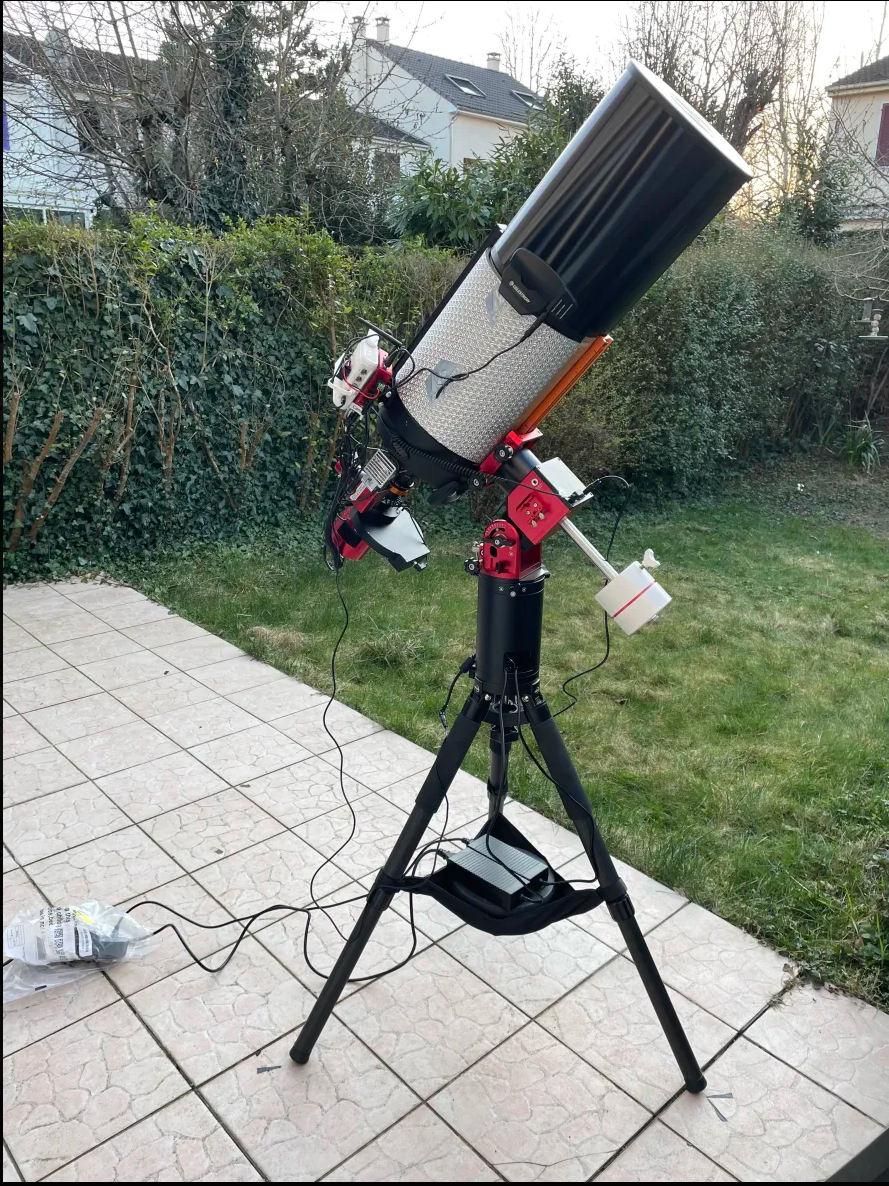 |
You cannot like this item. Reason: "ANONYMOUS".
You cannot remove your like from this item.
Editing a post is only allowed within 24 hours after creating it.
You cannot Like this post because the topic is closed.
Copy the URL below to share a direct link to this post.
This post cannot be edited using the classic forums editor.
To edit this post, please enable the "New forums experience" in your settings.
Recheck your basic steps.
I use almost the exact set up and have never had these issues
Is your back focus correct ( 105mm)?
How do you take your calibration frames: flats, bias, and darks, and how many of each?
Use an air bulb to clear the dust from your camera lens before imaging.
|
You cannot like this item. Reason: "ANONYMOUS".
You cannot remove your like from this item.
Editing a post is only allowed within 24 hours after creating it.
You cannot Like this post because the topic is closed.
Copy the URL below to share a direct link to this post.
This post cannot be edited using the classic forums editor.
To edit this post, please enable the "New forums experience" in your settings.
Im experimenting with a used C6 at F10+
I was bricking taking flats but a nasty old strip of once white t-shirt, £8 led tracing panel and Nina flat wizard seems to have made them comically easy.
Better flats should remove the donuts/dust bunnies. They did for me.
|
You cannot like this item. Reason: "ANONYMOUS".
You cannot remove your like from this item.
Editing a post is only allowed within 24 hours after creating it.
You cannot Like this post because the topic is closed.
Copy the URL below to share a direct link to this post.
This post cannot be edited using the classic forums editor.
To edit this post, please enable the "New forums experience" in your settings.
Loïck VIGER:
Hello Dan,
I have the same equipment as you and recently photographed M81 and M82 without any problems in an urban environment. See my astrobin post (https://www.astrobin.com/fs9tp5/) . When the Moon is out, it's important to have a dew shield: Celestron's aluminum ones are perfect!
Loïck
See my equipment below on my garden terrace.
 The Celestron aluminium dew shield you have looks fantastic, but they are relatively pricey. I'd get one if I could. I went with an angel eyes roll up alternative from Ali express for £15. It seems to do the job just about. At least for a c6
|
You cannot like this item. Reason: "ANONYMOUS".
You cannot remove your like from this item.
Editing a post is only allowed within 24 hours after creating it.
You cannot Like this post because the topic is closed.
Copy the URL below to share a direct link to this post.
This post cannot be edited using the classic forums editor.
To edit this post, please enable the "New forums experience" in your settings.
Apart from having a dew shield in place which might help somewhat you have also an issue with vignetting which renders flattening more difficult but you can use one (or few) of of the light frames to create a sky flat which would allow to remedy some of the obvious flaws and possibly salvage the final stack (to an acceptable level). Needless to say the reason for this behavior is the reducer and you'll be better off binning the camera and image a f/10 if the target fits in the FOV.
I could go on describing how to do but not sure if it is a waste of time so if there is some interest I might do it.
|
You cannot like this item. Reason: "ANONYMOUS".
You cannot remove your like from this item.
Editing a post is only allowed within 24 hours after creating it.
You cannot Like this post because the topic is closed.
Copy the URL below to share a direct link to this post.
This post cannot be edited using the classic forums editor.
To edit this post, please enable the "New forums experience" in your settings.
Thanks for all the replies so far. I have the aluminum dew shield from celestron. I take flats with the flat wizard in Nina and a led light panel and a white tshirt. I am 90% sure my backfocus is correct. I have the reducer then the celestron oag then the 2600mc with a spacer. I am traveling right now so I don’t have the exact measurement with me. I have cleaned the sensor and glass with the air in the past. I will keep trying to tweak things.
|
You cannot like this item. Reason: "ANONYMOUS".
You cannot remove your like from this item.
Editing a post is only allowed within 24 hours after creating it.
You cannot Like this post because the topic is closed.
Copy the URL below to share a direct link to this post.
This post cannot be edited using the classic forums editor.
To edit this post, please enable the "New forums experience" in your settings.
Andrea
I image at f5 with my refractor so I was trying the reducer for the f7. Do you think bin 2 with the 2600mc and exposure lengths 2-5min will be ok for small galaxies and PN?
I have been imaging for a few years with my refractor and just got my sct a few months ago and have been slowly tweaking it as the clouds allow and it has been a much larger learning curve for sure.
|
You cannot like this item. Reason: "ANONYMOUS".
You cannot remove your like from this item.
Editing a post is only allowed within 24 hours after creating it.
You cannot Like this post because the topic is closed.
Copy the URL below to share a direct link to this post.
This post cannot be edited using the classic forums editor.
To edit this post, please enable the "New forums experience" in your settings.
Dan,
Yes, a pixel scale of 0.76"/px is more than sufficient in average seeing, If seeing is especially gracious and the target is bright enough you can always go for full scale.
|
You cannot like this item. Reason: "ANONYMOUS".
You cannot remove your like from this item.
Editing a post is only allowed within 24 hours after creating it.
You cannot Like this post because the topic is closed.
Copy the URL below to share a direct link to this post.
This post cannot be edited using the classic forums editor.
To edit this post, please enable the "New forums experience" in your settings.
I'm not sure about the Edge 8 reducer but the Edge 11 and Edge 14 reducers performed poorly in my case and I ditched them (this was once I was running the F14 and it was upon the very good advice of John Hayes). Running at a long focal length (3910mm in my case) can be quite rewarding once you've pinned a few things down - dithering is definitely of paramount concern and seeing conditions can wreck what appears to be a perfectly clear night that may offer no problems on a short FL meaning that patience is required. I have been running at Bin 2 until recently but I am now experimenting with Bin 1 and do see some improvments (John also told me that Bin 2 produces 14 bit as opposed to the native Bin 1 16 bit; at least on the ASI6200). Your M81 would do well on Bin1 I think.
|
You cannot like this item. Reason: "ANONYMOUS".
You cannot remove your like from this item.
Editing a post is only allowed within 24 hours after creating it.
You cannot Like this post because the topic is closed.
Copy the URL below to share a direct link to this post.
This post cannot be edited using the classic forums editor.
To edit this post, please enable the "New forums experience" in your settings.
The reducer is 99.99% the reason for this. I went through the exact same thing a couple of months ago and got some invaluable help from another member who also had been through the same. In short I got rid of the reducer which was fine with smaller sensors (and perhaps NB) but after that no issues at all. Imaging at F/10 I have been using 60-120s mostly. But yeah, unless you can guide/track at 0.38" average you will need to bin in post. I downsample x2 in Pixinsight which works fine. If you want to look at my thread click here.
|
You cannot like this item. Reason: "ANONYMOUS".
You cannot remove your like from this item.
Editing a post is only allowed within 24 hours after creating it.
You cannot Like this post because the topic is closed.
Copy the URL below to share a direct link to this post.
This post cannot be edited using the classic forums editor.
To edit this post, please enable the "New forums experience" in your settings.
The Reducers on the 8HD are hot garbage. I've seen 50% increases in spot size, leading to massive sharpness issues. I've also noticed that the ADU's are nearly equal at the same exposure lengths with the F/7 reducer, as if the increase of glass leads to an equal speed as F/10. Regardless, I've found F/10 to be sharper, and more friendly to APS-C and larger sensors. The 8HD can nearly correct the entire field of view if it werent for the vignette.
Nothing should really change at F/10, go for about 1.25x the integration you would have gone for just for safe measure.
I would also downsample your images to about 0.6"/px.
If you decide to stay at F/7, with the flats you want to try to match the background brightness across the flats and lights. It's super sensitive to invariance.
|
You cannot like this item. Reason: "ANONYMOUS".
You cannot remove your like from this item.
Editing a post is only allowed within 24 hours after creating it.
You cannot Like this post because the topic is closed.
Copy the URL below to share a direct link to this post.
This post cannot be edited using the classic forums editor.
To edit this post, please enable the "New forums experience" in your settings.
The dust bunny's could be on your filters too. I have the same gear, but I removed my filter wheel and replaced with a single filter holder. When I start to get dust bunnies I clean both filter and camera. This has help me no end. Although my camera is a 533mm being the only difference.
Absolutely check your back focus too 105 for your setup I use electronic calibers.
Good luck, everything else setup wise after having this set is breeze.
|
You cannot like this item. Reason: "ANONYMOUS".
You cannot remove your like from this item.
Editing a post is only allowed within 24 hours after creating it.
You cannot Like this post because the topic is closed.
Copy the URL below to share a direct link to this post.
This post cannot be edited using the classic forums editor.
To edit this post, please enable the "New forums experience" in your settings.
Although my camera is a 533mm being the only difference. This makes all the difference though.
|
You cannot like this item. Reason: "ANONYMOUS".
You cannot remove your like from this item.
Editing a post is only allowed within 24 hours after creating it.
You cannot Like this post because the topic is closed.
Copy the URL below to share a direct link to this post.
This post cannot be edited using the classic forums editor.
To edit this post, please enable the "New forums experience" in your settings.
Jan Erik Vallestad:
Although my camera is a 533mm being the only difference.
This makes all the difference though. My reply was aimed at the dust bunny's, irrespective of camera. Donuts like in image linked is cleaning of sensor area and filter ( if the filter is super close to the sensor). Some one kindly pointed in my early days, that donuts appear very close to sensor. And actually 533mm/mc( i have both) is way worst than the 2600mc. Lots of useful info for the poster being posted, which always good. It's interesting re the reducer I've heard alot about them not being effective. I've never tried mine without, something I may try and remove and see the difference.
|
You cannot like this item. Reason: "ANONYMOUS".
You cannot remove your like from this item.
Editing a post is only allowed within 24 hours after creating it.
You cannot Like this post because the topic is closed.
Copy the URL below to share a direct link to this post.
This post cannot be edited using the classic forums editor.
To edit this post, please enable the "New forums experience" in your settings.
Jan Erik Vallestad:
Although my camera is a 533mm being the only difference.
This makes all the difference though.
My reply was aimed at the dust bunny's, irrespective of camera. Donuts like in image linked is cleaning of sensor area and filter ( if the filter is super close to the sensor). Some one kindly pointed in my early days, that donuts appear very close to sensor. And actually 533mm/mc( i have both) is way worst than the 2600mc.
Lots of useful info for the poster being posted, which always good. It's interesting re the reducer I've heard alot about them not being effective. I've never tried mine without, something I may try and remove and see the difference.
I used my IMX533 with the reducer which was just fine. Everything calibrated as it should and I never really knew about these issues, which are sensor-size dependant. Hence the "533 vs 2600 makes all the difference" comment, it was not meant in a bad way! I get what you're saying about the dust motes, but they were also part of the symptoms I saw when troubleshooting on my own - without there being anything wrong with the actual flats. Sadly I've lost most of the data from back then, but this is a 20 second sample (1x5s each of LRGB) with the 533MM, calibrated: 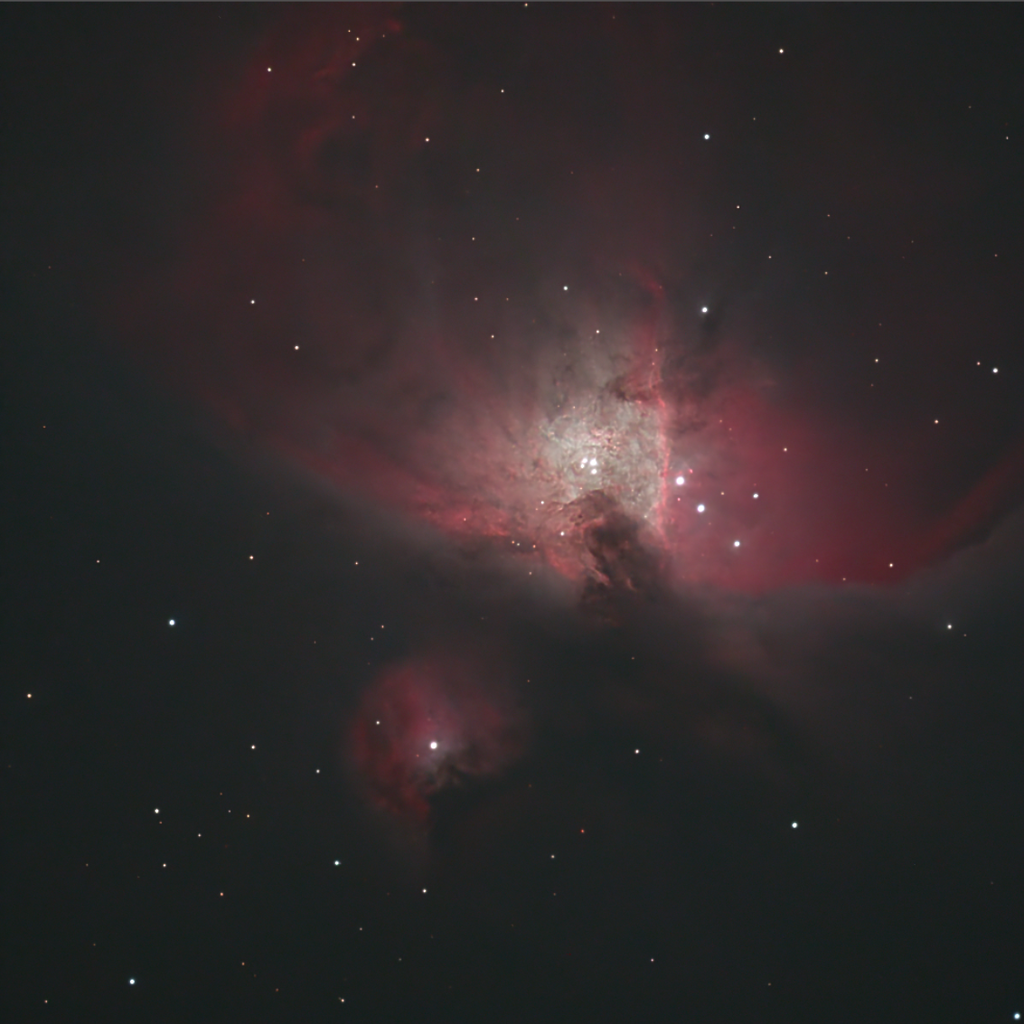 Then there's the calibrated 2600MC stack of about 12 hours: 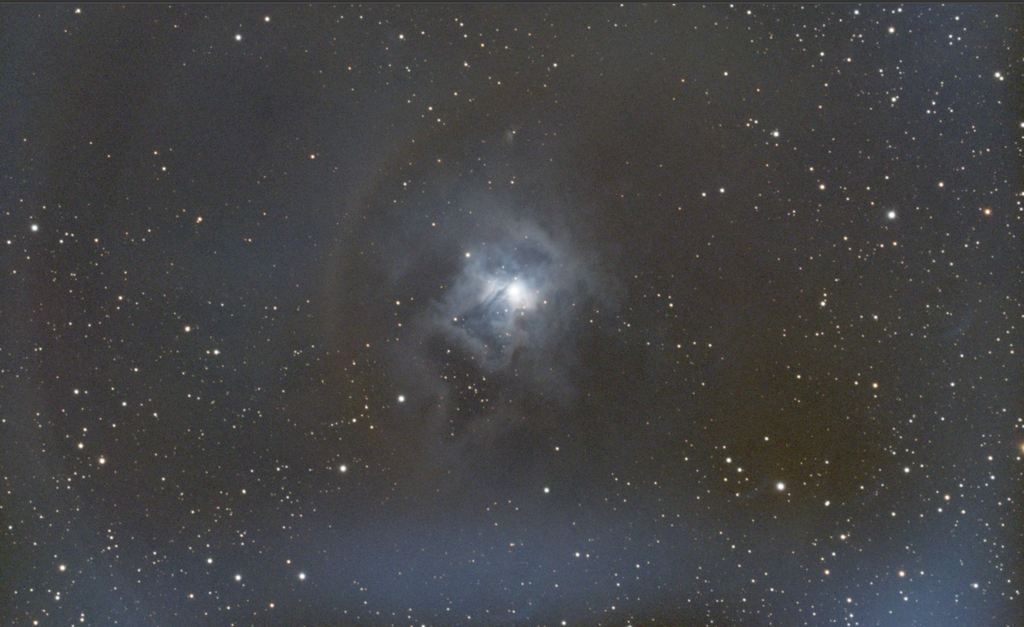 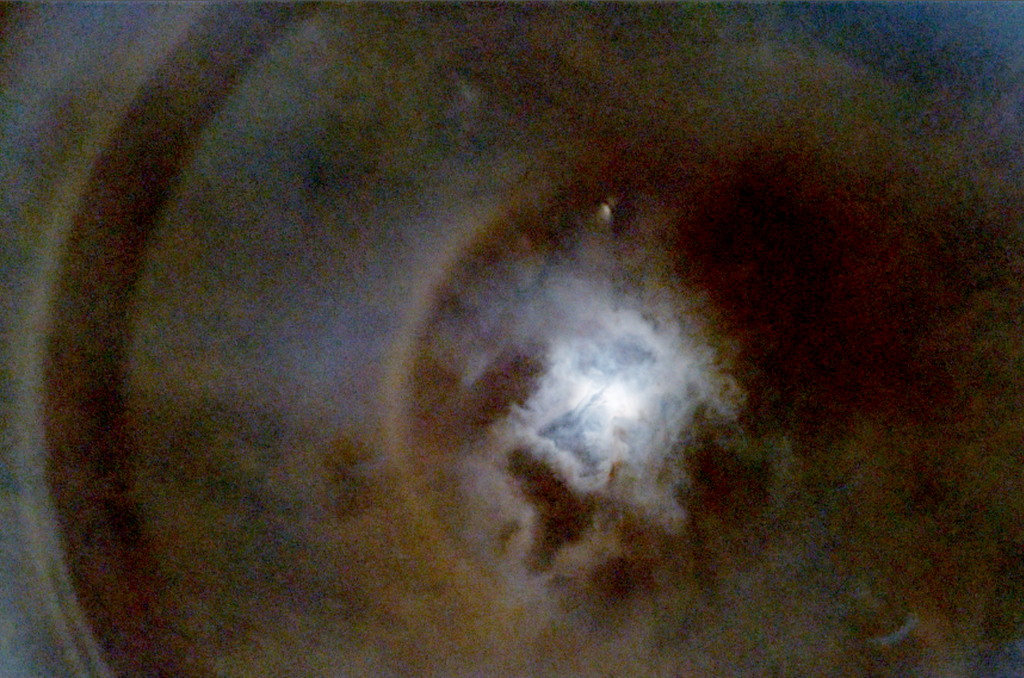 The only change was the sensor size. Same scope, same reducer and the same image train more or less as well as still shooting broadband data. Clear circles where the light has reflected on the bright inner sides of it and left over dust motes (even though they were in the flat frames). As soon as the reducer was removed every dust mote got calibrated and no more circles. If I was still using my IMX533 in stead of IMX571 cameras still I would probably not have this issue at all. I was told that NB data would probably not have those reflections either- but I have not done any more testing. Clear, dark nights are too few to be spent messing around with that reducer  Personally I didn't remove it due to lack of sharpness, I thought the data looked quite good besides the obvious issues. I was also told by Celestron that the reducer was faulty, which implies that they do make ones that aren't. Maybe its a early batch problem, but I'm not tempted to test that theory as long as most people I talk to seem to have the exact same experience.
|
You cannot like this item. Reason: "ANONYMOUS".
You cannot remove your like from this item.
Editing a post is only allowed within 24 hours after creating it.
You cannot Like this post because the topic is closed.
Copy the URL below to share a direct link to this post.
This post cannot be edited using the classic forums editor.
To edit this post, please enable the "New forums experience" in your settings.
how about dew issues?..also besides the moon
|
You cannot like this item. Reason: "ANONYMOUS".
You cannot remove your like from this item.
Editing a post is only allowed within 24 hours after creating it.
You cannot Like this post because the topic is closed.
Copy the URL below to share a direct link to this post.
This post cannot be edited using the classic forums editor.
To edit this post, please enable the "New forums experience" in your settings.
Hello Dan,
I noticed that on your 5th image, the donuts from dust are present on the image.
This should normally be removed by flats.
This same problem occurred to me long time ago, and the reason was that the bias (or offset) of either my flats or my images was not properly removed.
On your images the dust donuts appears white, meaning that your flats are overcorrecting the image. I think this can happen when image bias is not fully subtracted or when flat bias is over substracted.
Hope this could help you …
Daniel
|
You cannot like this item. Reason: "ANONYMOUS".
You cannot remove your like from this item.
Editing a post is only allowed within 24 hours after creating it.
You cannot Like this post because the topic is closed.
Copy the URL below to share a direct link to this post.
This post cannot be edited using the classic forums editor.
To edit this post, please enable the "New forums experience" in your settings.
I have an edge hd8 and use the 0.7 reducer on it and have no issues. I am able to process out the dust motes with flats and don't see the halo like gradient in your images. I certainly think it is possible to have clean images at F10 or F7 when you use calibration frames because that has been my experience. It might help to take a careful look at your acquisition and processing of flats because you should have the same experience I am having.
|
You cannot like this item. Reason: "ANONYMOUS".
You cannot remove your like from this item.
Editing a post is only allowed within 24 hours after creating it.
You cannot Like this post because the topic is closed.
Copy the URL below to share a direct link to this post.
This post cannot be edited using the classic forums editor.
To edit this post, please enable the "New forums experience" in your settings.
Dan,
You’ve received a lot of good advice here but I’m going to toss in my two cents anyway.
1) In my experience, reducers are almost always problematic. A few work but most introduce excessive optical aberration, stray reflections, or extreme vignetting. So, my first recommendation is to get rid of the reducer. You certainly don’t need it for imaging M82—or for that matter, most galaxies.
2) It looks like you have a combination of too much vignetting and perhaps some internal stray reflections. Removing the reducer will probably fix the vignetting problem. Make sure that all of the internal surfaces of your connector tubes are well blackened. Also make sure that there are no light leaks anywhere in your imaging train.
3) Dust motes appear for only two reasons: A) something moved (or changed) causing a registration problem or B) your calibration data is not being properly applied. First, clean out all that dust! Take everything apart in a clean environment, wear gloves and a face mask, and blow out ALL of the dust. Examine the surfaces under a bright light to make sure that there are ZERO particles on the optics and sensor. Then reassemble the system and use high quality vinyl tape to seal any gaps so that dust cannot get in. Then make sure that you are properly calibrating your data using flats, matched darks, and bias.
Get everything working flawlessly without the reducer and then if you want to go back to try it again, you’ll be able to more easily isolate problems that it might be causing. Again, I don’t recommend using a reducer. It is much better to get a bigger sensor to gain FOV.
Good luck with it!
John
|
You cannot like this item. Reason: "ANONYMOUS".
You cannot remove your like from this item.
Editing a post is only allowed within 24 hours after creating it.
You cannot Like this post because the topic is closed.
Copy the URL below to share a direct link to this post.
This post cannot be edited using the classic forums editor.
To edit this post, please enable the "New forums experience" in your settings.
Sorry for the delay in replying to everyone as I am traveling. Thank you for all of the help and advice!!! You guys are great. I will have some things to do/try when I get home and it is clear!
|
You cannot like this item. Reason: "ANONYMOUS".
You cannot remove your like from this item.
Editing a post is only allowed within 24 hours after creating it.
You cannot Like this post because the topic is closed.
Copy the URL below to share a direct link to this post.
This post cannot be edited using the classic forums editor.
To edit this post, please enable the "New forums experience" in your settings.
I'm having a similar issue with my EdgeHD800 (no reducer) where my flats are waaaay overcorrecting. Instead of uncorrected dark spots, I have white donuts as dust bunny's and a complete reverse vignette. This only started when I moved to Voyager though. Never had this problem with NINA and the Flat Wizard. On Voyager, I have tried Sky Flats and flats with a normal panel as well with no change. I just got an EL panel which I am going to try tommorow.
One interesting thing I find between NINA and Voyager is that my ASI2600 has a different horizontal resolution, at least when I am BIN'd 2x2. NINA is 3120x2088 and Voyager is 3124x2088. I need to look back through some old data but I dont believe this is the case at 1x1.
|
You cannot like this item. Reason: "ANONYMOUS".
You cannot remove your like from this item.
Editing a post is only allowed within 24 hours after creating it.
You cannot Like this post because the topic is closed.
Copy the URL below to share a direct link to this post.
This post cannot be edited using the classic forums editor.
To edit this post, please enable the "New forums experience" in your settings.
I'm 80% certain it's dark, bias, flat, light incompatible. I got similar issues in the past too. First step is check bias/flat/light/dark are all same gain and offset, and dark/light has same time, while flat frame is 1ms and different than flat time is ok, keep flat around 50% if possible. Another possible problem is moon light as mentioned before, it will break the original calibration balances and caused those floating 3d-looking donuts. You could have another try in no-moon nights, and keep every calibration aligned, to identify the problem
|
You cannot like this item. Reason: "ANONYMOUS".
You cannot remove your like from this item.
Editing a post is only allowed within 24 hours after creating it.
You cannot Like this post because the topic is closed.
Copy the URL below to share a direct link to this post.
This post cannot be edited using the classic forums editor.
To edit this post, please enable the "New forums experience" in your settings.
Loïck VIGER:
Hello Dan,
I have the same equipment as you and recently photographed M81 and M82 without any problems in an urban environment. See my astrobin post (https://www.astrobin.com/fs9tp5/) . When the Moon is out, it's important to have a dew shield: Celestron's aluminum ones are perfect!
Loïck
See my equipment below on my garden terrace.
 Completely off-topic but..... that's a pretty glorious set-up you've got there :-)
|
You cannot like this item. Reason: "ANONYMOUS".
You cannot remove your like from this item.
Editing a post is only allowed within 24 hours after creating it.
You cannot Like this post because the topic is closed.
Copy the URL below to share a direct link to this post.
This post cannot be edited using the classic forums editor.
To edit this post, please enable the "New forums experience" in your settings.
Hello everybody - I bought a used Celestron EdgeHD 8" about a year ago in very good condition. I also struggled to get satisfying pictures first especially compared to my refractors (RedCat 51 and ASKAR 103 APO). Actually I'm using the Celestron 0.7 Reducer with the ZWO ASI2600MC duo Camera. I'm also using a ZWO EAF to focus and just yesterday installed the ZWO CAA. From my point of view here some of the problems I had to solve: - Check for correct collimation - Check the focus using a Bathimov mask - Use the correct flat frames taken during the actual image session (Some times I used the wrong flats and the result was frustrating) - Check for dust on the different surfaces of your image gear - Use a dew shield and heating - A sturdy tripod, stable platform and capable mount are also very important with this focal length I'm far from using the full potential of this scope nevertheless I'm quite happy with the galaxy season so far (see my pictures on Astrobin) Clear Skies - Beat 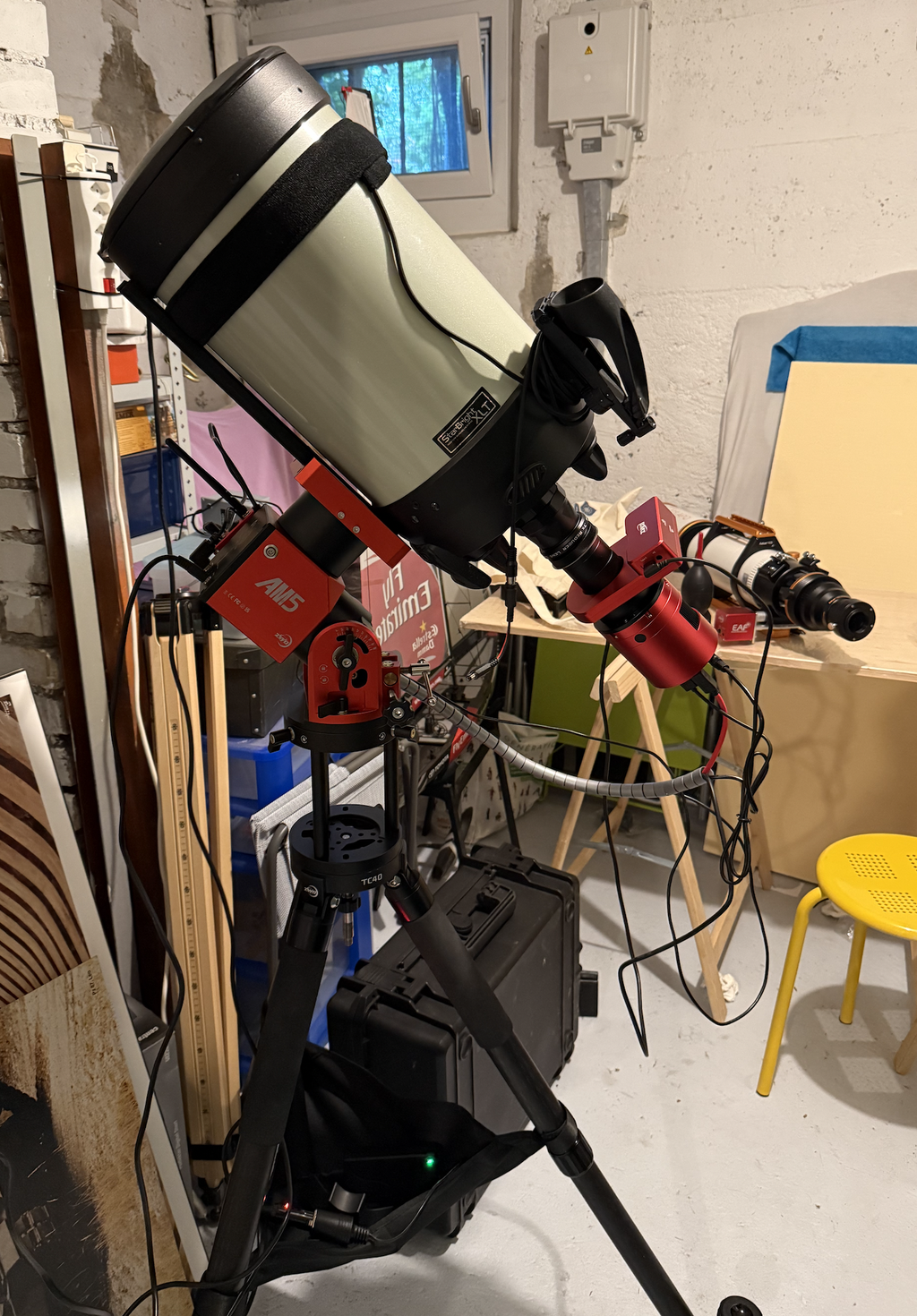 |
You cannot like this item. Reason: "ANONYMOUS".
You cannot remove your like from this item.
Editing a post is only allowed within 24 hours after creating it.
You cannot Like this post because the topic is closed.
Copy the URL below to share a direct link to this post.
This post cannot be edited using the classic forums editor.
To edit this post, please enable the "New forums experience" in your settings.
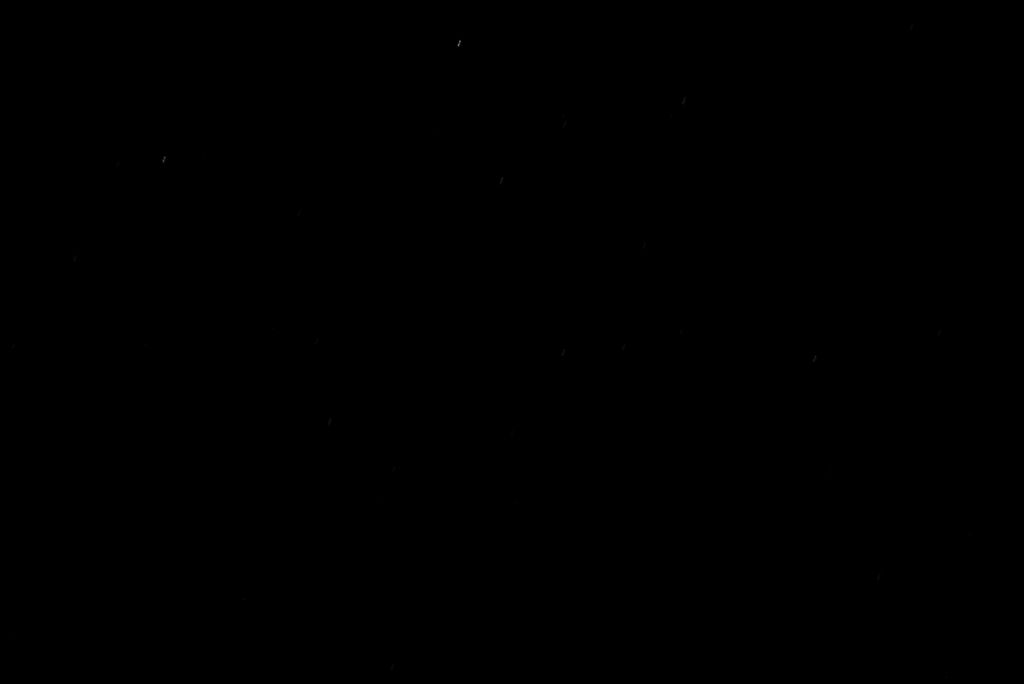


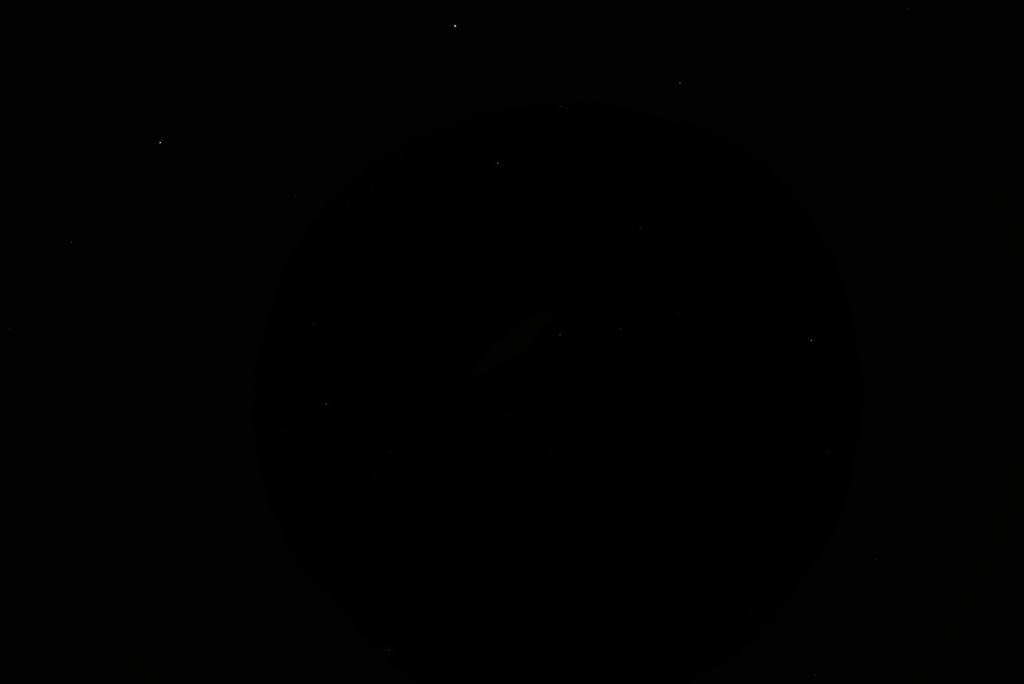
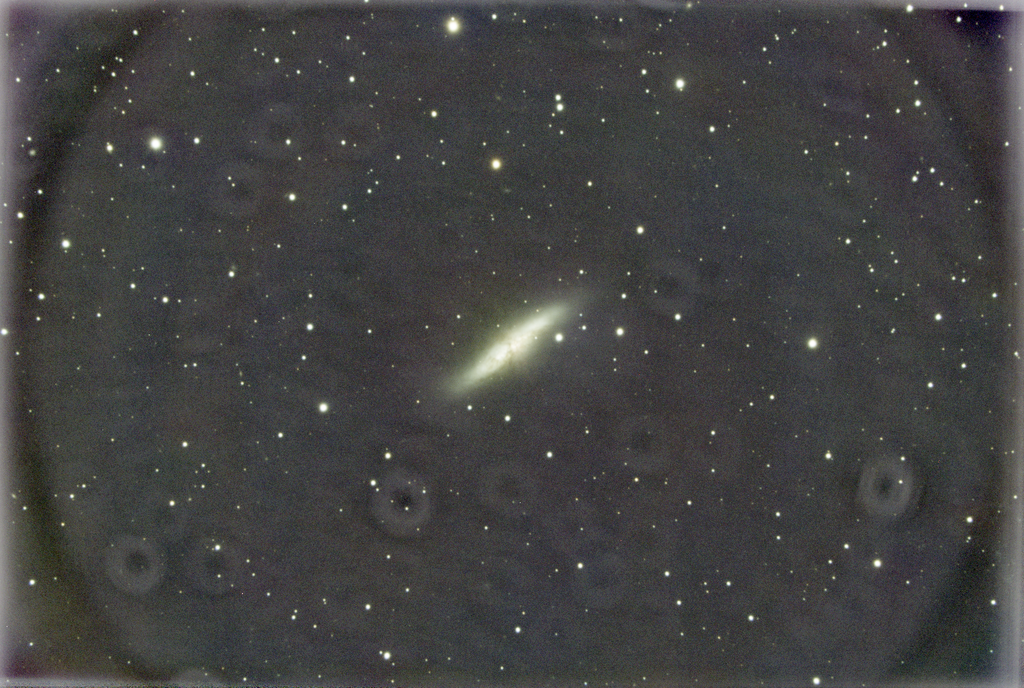

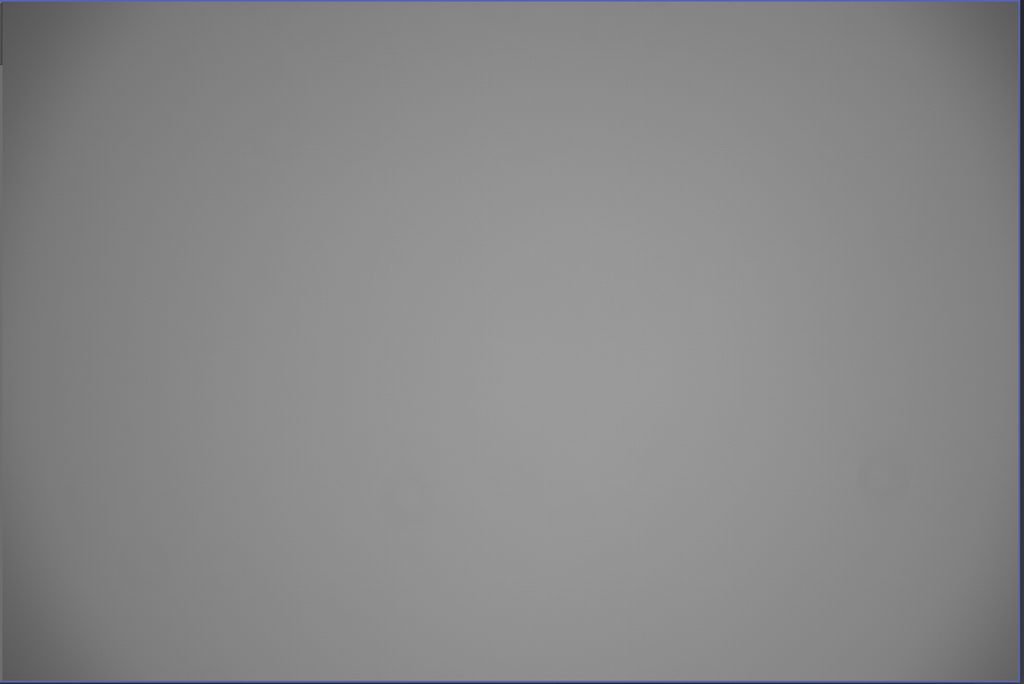
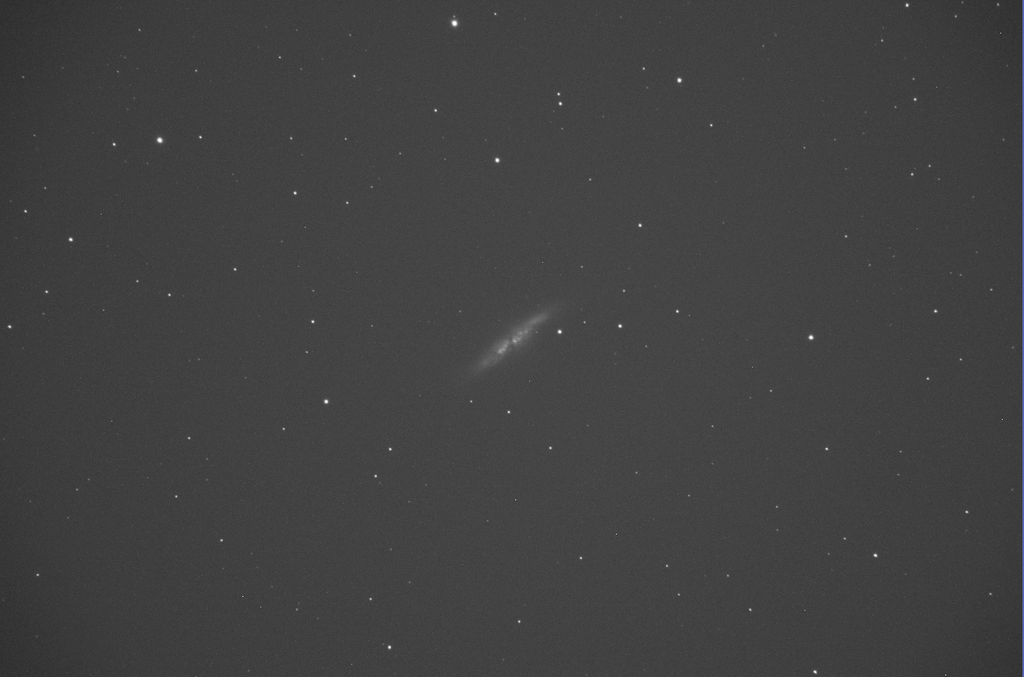
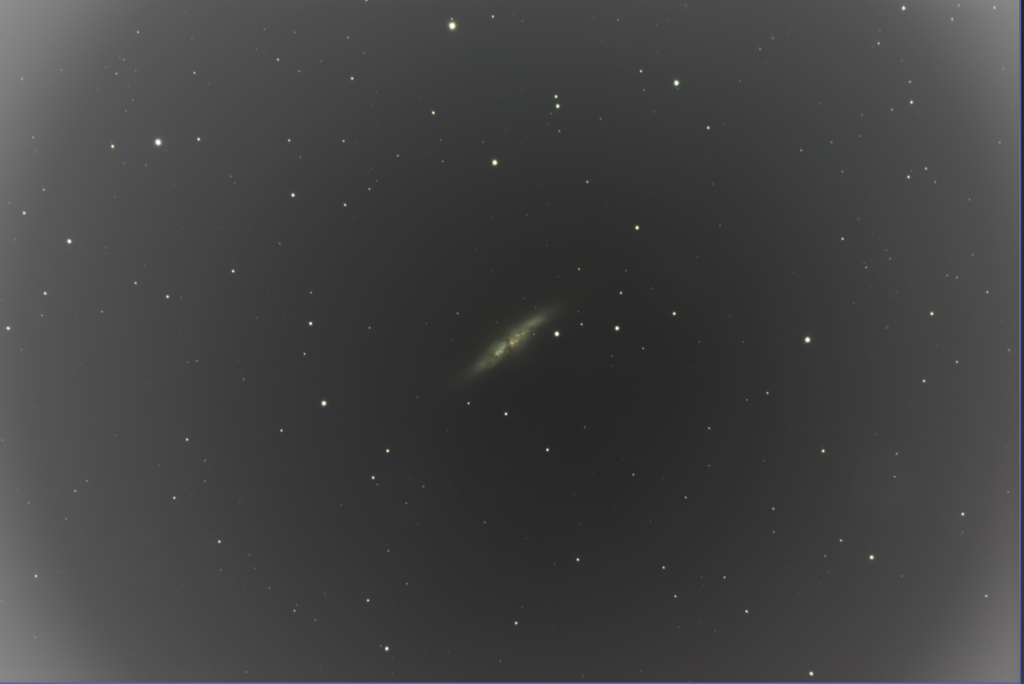 Thankyou for your help.
Thankyou for your help.







